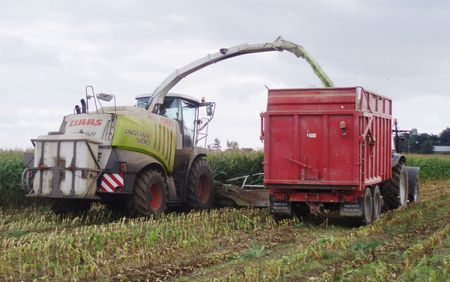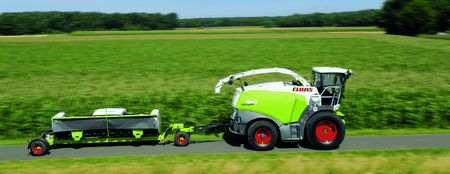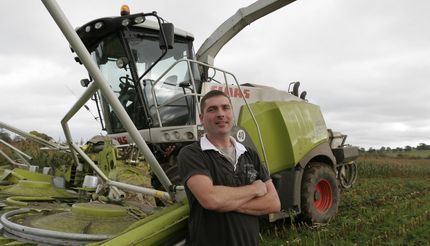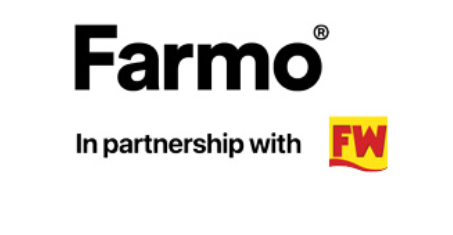With a silage workload of about 5000ha (12,500 acres) from grass, whole crop and maize crops, North Yorkshire contracting outfit Metcalfe Farms has a busy schedule to cope with.
It’s enough to ensure that two 623hp Claas Jaguar 900s have been kept working to maximum capacity – often requiring a third 900 to be hired in to cope with peak demands.
But this season, things have been a little different. The arrival of a pre-production twin-engined Jaguar packing 830hp has avoided the need to hire that third forager, leaving the workload in the capable hands of just two silage teams.
“It’s all about productivity,” says Brian Metcalfe. “You can make a big forager go slower, but you can’t make a smaller forager go faster.”

Jaguar’s 900 moniker is just a disguise. Note the twin exhaust pipes – this curvy beast packs two 415hp engines.
He recounts the season so far, and accepts that the role of the soon-to-be-badged “980” has not been to chase maximum capacity at all costs, but to use the added muscle to grab extra output here and there, to stay on target with customers’ preferred mowing dates, and not let constantly changing crop densities and weather patterns sway efficiency.
“It’s the way forward,” he says. “There are always areas where you lose time, and the extra capacity at our fingertips just gives us the flexibility and versatility we need.”
With the ability to dispatch 12-tonne loads in less than 40 seconds, he reckons trailers now spend more time moving material to clamp, instead of wasting time under the forager spout.
And despite the hike in power, trailer requirements have barely changed. One extra 12-tonner has been added to the team, although clamping is under close scrutiny.
“On the larger farms where output is high and clamp space is generous, we may opt to use two mid-sized loaders instead of one large one,” he says. “There is no set system – it’s all down to flexibility, and we’ll have to closely evaluate our clamping regime for next season.”

Using only one engine saves fuel when travelling between farms. A flick of a switch alters tyre pressures on the move.
| View from the seat * Operator Richard Marsden has spent his summer on board the 980 and reckons that compared with the previous 900 model, the twin-engined machine is in a different league. “Maize used to be a chore with the old 900 and an RU header,” he says. “Blockages were commonplace, too. But the 980 and 10-row Orbis header is leaps ahead. And the machine’s appetite in grass is phenomenal. “The feed rollers hinge out for better access, the drum and curved blade design is better, chop lengths are easier to adjust from 3.5mm up to 37.5mm, and on-the-move tyre pressure adjustment makes it easy to adapt the machine for road and field operations. And there’s adjustable crop blowing capacity, too.” But the best flexibility, says Mr Marsden, is having the variable performance of two engines at his fingertips. “I have the option of running just one engine,” he says. “And 415hp can be adequate in light, third-cut crops, although using just one engine also saves fuel on the road too. “We now spend more time running back and forth to farms than we ever did, so this is a very useful fuel-saving feature.” A glance at the hour meters reveals that engine one has clocked up 1120 hours while engine two has covered just 720 hours, supporting his flexibility argument. But Mr Marsden suggests that Claas could have made the flagship forager a much better tool by upping the ante to 1000hp. “A 623hp Jag 900 engine combined with one of the 980’s 415hp motors would give me much more versatility to respond to crop density, type and desired output,” says Mr Marsden. “There have been plenty of times when 830hp has not been enough.” He says the Jaguar has seen off 150 acres of maize in 10 hours, but using the electronic engine management enables maximum engine revs to be set anywhere between 1800 and 2100rpm, varying forager output accordingly. “Despite the machine’s huge capability, we just don’t need to be running at 110% all the time,” he says. “But it’s there when we really need it.” 
Richard Marsden has spent 15 years driving foragers for Metcalfe Farms – the twin-engined 980 is comfortably the best he’s operated by far, but he reckons it should be packing 1000hp. |
| Claas jaguar 980 |
- Power 830hp
- Engines 2 x 12.7-litre Daimler Chrysler 6-cyl common-rail turbo linked by belt-drive
- Chopper 750mm wide drum, 36/18-blade, 7-25mm chop
- Transmission Twin-speed hydrostatic, 4WD, 40kph
- Price £279,500
|





